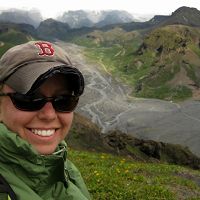Driscoll et al., 2012
Hydrologic response to modeled snowmelt input in alpine catchments in the Southwestern United States
Driscoll J.M., Molotch N.P., Jepsen S.M., Meixner T., Williams M.W., Sickman J.O. (2012)
Abstract H51B-1336 presented at 2012 Fall Meeting, AGU, San Francisco, Calif., 3-7 Dec (Poster). Cross-CZO
-
Catalina-Jemez, GRAD STUDENT
-
Boulder, Sierra, INVESTIGATOR
-
Catalina-Jemez, INVESTIGATOR
-
Boulder, INVESTIGATOR
Abstract
Snowmelt from high elevation catchments is the primary source of water resources in the Southwestern United States. Timing and duration of snowmelt and resulting catchment response can show the physical and chemical importance of storage at the catchment scale. Storage of waters in subsurface materials provides a physical and chemical buffer to hydrologic input variability. We expect the hydrochemistry of catchments with less storage capacity will more closely reflect input waters than a catchment with more storage and therefore more geochemical evolution of waters. Two headwater catchments were compared for this study; Emerald Lake Watershed (ELW) in the southern Sierra Nevada and Green Lake 4 (GL4) in the Colorado Front Range. These sites have geochemically similar granitic terrane, and negligible evaporation and transpiration due to their high-elevation setting. Eleven years of data (1996-2006) from spatially-distributed snowmelt models were spatially and temporally aggregated to generate daily values of snowmelt volume for each catchment area. Daily storage flux was calculated as the difference between snowmelt input and catchment outflow at a daily timestep, normalized to the catchment area. Daily snowmelt values in GL4 are more consistent (the annual standard deviation ranged from 0.19 to 0.76 cm) than the daily snowmelt in ELW (0.60 to 1.04 cm). Outflow follows the same trend, with an even narrower range of standard deviations from GL4 (0.27 to 0.54 cm) compared to the standard deviation of outflow in ELW (0.38 to 0.98 cm). The dampening of the input variability could be due to storage in the catchment; the larger effect would mean a larger storage capacity in the catchment. Calculations of storage flux (the input snowmelt minus the output catchment discharge) show the annual sum of water into storage in ELW ranges from -0.9200 to 1.1124 meters, in GL4 the ranger is narrower, from -0.655 to 0.0992 meters. Cumulative storage for each year can be negative (more water leaving the system than entering; storage loss) or positive (more water coming into the system than leaving; storage gain). The cumulative storage for all years in GL4 show a similar positive trend from day of year 60 through 150, followed by a decrease to the end of the snowmelt season. Only two years (1997 and 2005) in GL4 were calculated to cumulatively gain storage water, the other nine years lost stored water to outflow. The cumulative storage annual data in ELW do not show as strong of a trend for all years. ELW also a different distribution of cumulative storage values; with four years showing a cumulative loss and seven years showing a gain in stored water. This could show a depletion of stored water, an underestimate of snowmelt or a connection to deeper flowpaths. Mass-balance inverse geochemical models will be used to determine the hydrochemical connectivity or lack of connectivity of snowmelt to outflow relative to the physical calculations. Initial hydrochemical results show generally higher concentrations of solutes from GL4 outflow, which may show more contribution from stored waters.
Citation
Driscoll J.M., Molotch N.P., Jepsen S.M., Meixner T., Williams M.W., Sickman J.O. (2012): Hydrologic response to modeled snowmelt input in alpine catchments in the Southwestern United States . Abstract H51B-1336 presented at 2012 Fall Meeting, AGU, San Francisco, Calif., 3-7 Dec (Poster)..
Explore Further




